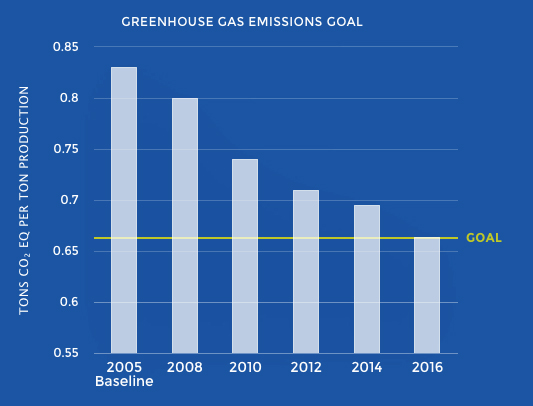| |
 · www.tappi.org
· www.tappi.org
· Subscribe
to Ahead of the Curve
· Newsletters
· Ahead
of the Curve archived issues
· Contact
the Editor

|
|
|
|
US Paper and Wood Products Manufacturers Report Sustainability Progress
The American Forest & Paper Association (AF&PA) has released its 2018 Sustainability Report, which highlights the US pulp, paper, packaging, tissue, and wood products manufacturing industry's contributions to sustainability across the value chain, including members' progress toward achieving the Better Practices, Better Planet 2020 sustainability goals. One of the report's main findings: Two of the six sustainability goals have been achieved ahead of the original 2020 deadline.

According to the report, in 2016, the GHG emissions of AF&PA member companies—measured in carbon dioxide equivalents (CO2 eq) per ton of production—were 19.9 percent lower than in 2005. (Table from AF&PA website.)
"We are pleased to represent companies that advance economic, environmental, and social values," said AF&PA President and CEO Donna Harman in a press release from the organization. "Their commitment led them to achieve the Better Practices, Better Planet 2020 goals to improve energy efficiency and worker safety ahead of schedule."
The press release also quoted John Rooney, CEO of GEC Packaging Technologies and chairman of the AF&PA Board of Directors. "On behalf of all AF&PA members, I am proud of the progress we've made together," Rooney said. "We are committed to continuing our industry's sustainability leadership while making essential products for everyday life."
The AF&PA shared several other highlights of its 2018 Sustainability Report, including the following:
• AF&PA member purchased energy per ton of production was reduced by 11.6 percent—surpassing the goal of at least 10 percent improvement in purchased energy efficiency ahead of the 2020 deadline.
• Members' safety incidence rate is 36.3 percent better than the 2006 baseline. While members have surpassed the 25 percent improvement goal, they are continuing to work on the aspirational goal of zero workplace injuries.
• Members reduced greenhouse gas emissions from their facilities by 19.9 percent, nearly reaching their goal to achieve a 20 percent reduction in emissions.
• Member facilities are often located in rural communities where they frequently serve as the largest employer. More than 75 percent of all US pulp and paper mills are in counties that are more than 80 percent rural.
• Most AF&PA members have programs in place to support their employees' continuing education and career development efforts and offer internships and apprenticeships to attract a new generation of workers to the industry.
Three Pillars, Six Goals
Established in 2011, the Better Practices, Better Planet 2020 initiative aims to ensure the industry's sustainable consumption and production along the entire value chain, which aligns with the objectives of one of the United Nations Sustainable Development Goals (UNSDGs).
The report identifies what it calls the "Three Pillars of Sustainability": Economic, Environmental, and Social, and offers context for each:
ECONOMIC: The economic health of the US paper and wood products manufacturing industry is vital to its sustainable future. AF&PA advocates for government policies and regulations that allow the industry to remain competitive in order to manufacture products that people use and need. AF&PA believes that market forces should be the primary drivers of sustainability initiatives.
ENVIRONMENTAL: Our industry depends on the efficient and wise use of natural resources to make socially beneficial products. AF&PA members adhere to important environmental, health, safety and sustainable forestry and procurement principles. This ensures that our industry fulfills its responsibility to future generations.
SOCIAL: AF&PA members are an integral part of the communities in which they operate, often having provided jobs and taxes there for more than 100 years. They have a variety of programs to promote the well-being of their employees and local communities; over 75 percent of pulp and paper mills are located in counties that are more than 80 percent rural.
The report also details progress made on the six goals identified for the industry:
• Improving energy efficiency
• Increasing paper recovery for recycling
• Reducing greenhouse gas emissions
• Improving worker safety
• Promoting sustainable forestry
• Reducing water use
To illustrate the progress on these goals, the report highlights winners of the AF&PA's 2016 Sustainability Awards; featured companies include Sappi North America, Dart Container, WestRock, and International Paper.
"Our members make essential products for everyday life from renewable and recyclable resources," notes a letter from Harman on the report's website. "In addition, they are committed to continuous sustainability improvement through our unique Better Practices, Better Planet 2020 sustainability goals initiative…AF&PA invites you to review our sustainability performance and we welcome your feedback."
The full sustainability report, a video of highlights, and other information are available at https://sustainability.afandpa.org.
For a modest investment of $174, receive more than US$ 1000 in benefits in return.
Visit www.tappi.org/join for more details. |
|




